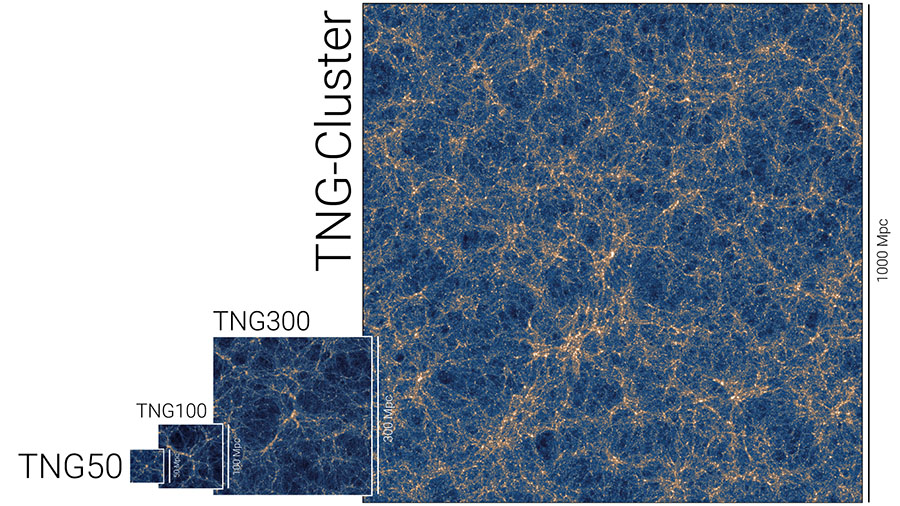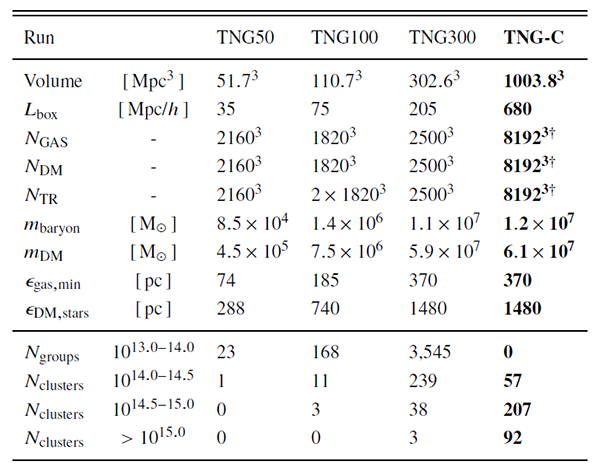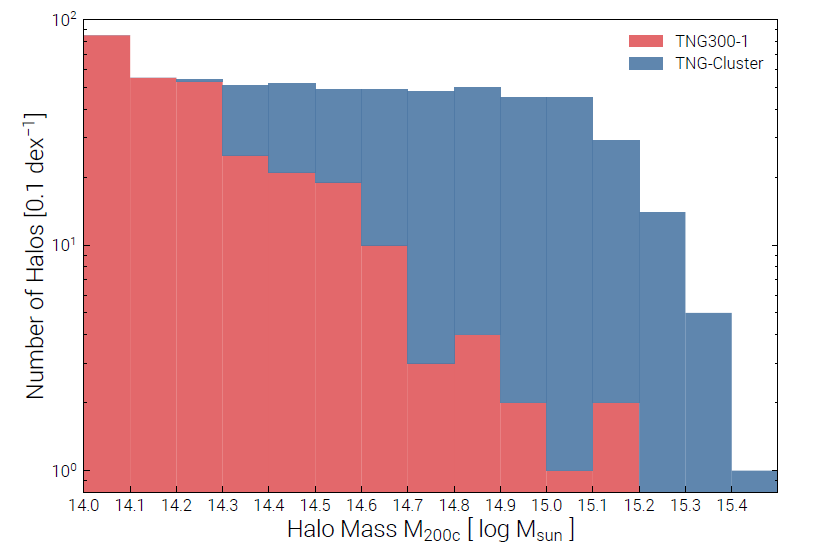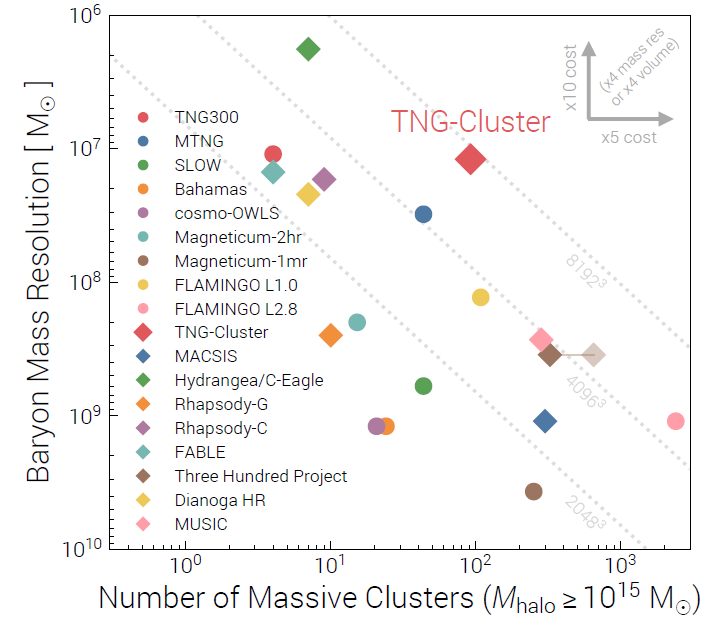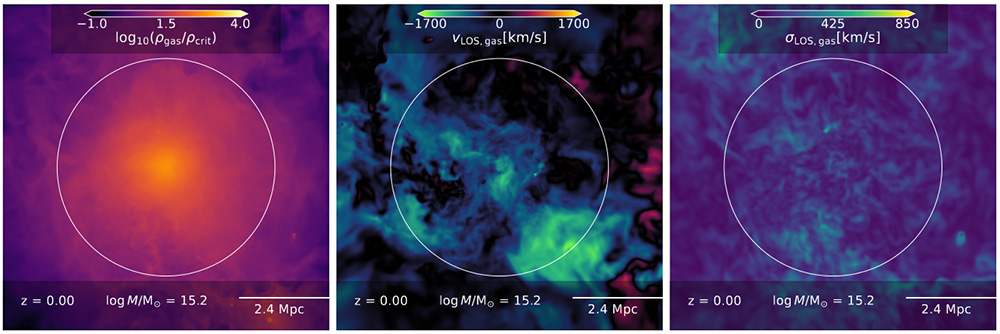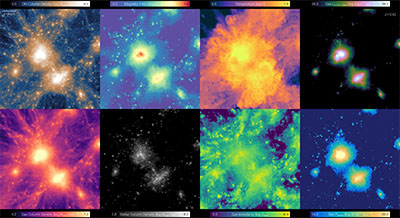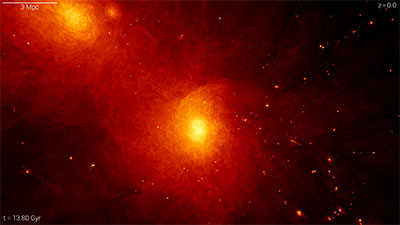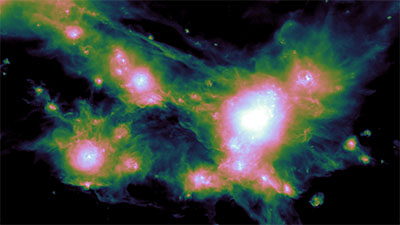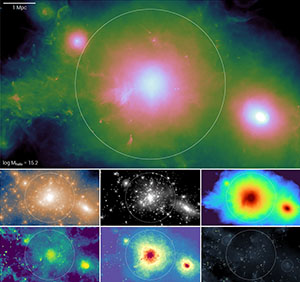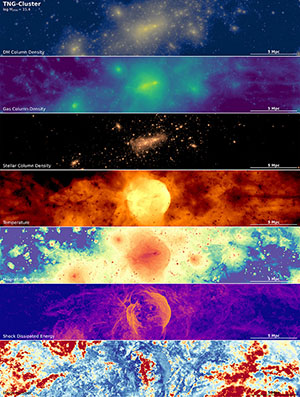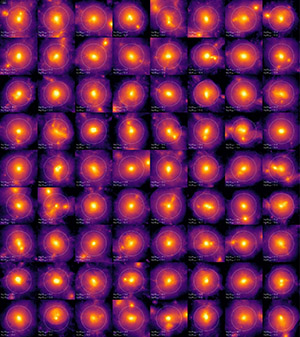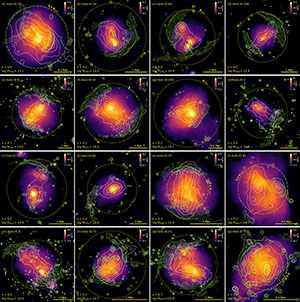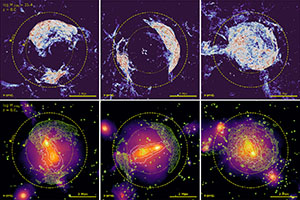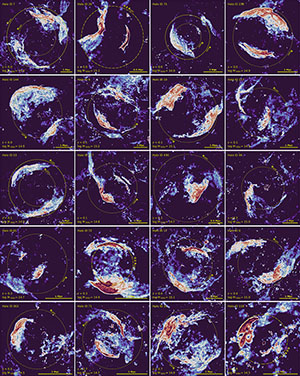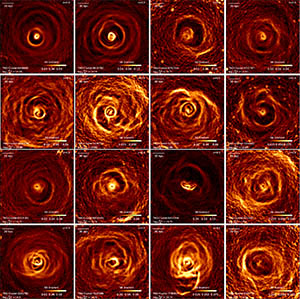Atacama Large Aperture Submillimeter Telescope (AtLAST) Science: Resolving the Hot and Ionized Universe through the Sunyaev-Zeldovich effect
Luca Di Mascolo, Yvette Perrott, Tony Mroczkowski, Stefano Andreon, Stefano Ettori, Aurora Simionescu, Srinivasan Raghunathan, Joshiwa van Marrewijk, Claudia Cicone, Minju Lee, Dylan Nelson, Laura Sommovigo, Mark Booth, Pamela Klaassen, Paola Andreani, Martin A. Cordiner, Doug Johnstone, Eelco van Kampen, Daizhong Liu, Thomas J. Maccarone, Thomas W. Morris, Amélie Saintonge, Matthew Smith, Alexander E. Thelen, Sven Wedemeyer
arXiv pre-print
[ads]
[arXiv:2403.00909] (March 1, 2024)
The cooler past of the intracluster medium in TNG-Cluster
Eric Rohr, Annalisa Pillepich, Dylan Nelson, Mohammadreza Ayromlou, Céline Péroux, Elad Zinger
MNRAS (2024)
[ads]
[arXiv:2410.19900] (Oct. 25, 2024)
X-ray cavities in TNG-Cluster: AGN phenomena in the full cosmological context
Marine Prunier, Julie Hlavacek-Larrondo, Annalisa Pillepich, Katrin Lehle, Dylan Nelson
arXiv pre-print
[ads]
[arXiv:2410.21366] (Oct. 28, 2024)
ERGO-ML: A continuous organization of the X-ray galaxy cluster population in TNG-Cluster with contrastive learning
Urmila Chadayammuri, Lukas Eisert, Annalisa Pillepich, Katrin Lehle, Mohammadreza Ayromlou, Dylan Nelson
arXiv pre-print
[ads]
[arXiv:2410.22416] (Oct. 29, 2024)
PSZ2 G181.06+48.47 III: weak-lensing analysis and merging scenario reconstruction of a low-mass cluster with exceptionally-distant radio relics
Eunmo Ahn, Hyejeon Cho, M. James Jee, Wonki Lee, Andra Stroe, Kamlesh Rajpurohit, Kyle Finner, William Forman, Christine Jones, Reinout van Weeren
arXiv pre-print
[ads]
[arXiv:2501.09067] (Jan. 15, 2025)
The abundance and origin of cool gas in galaxy clusters in the TNG-Cluster simulation
Milan Staffehl, Dylan Nelson, Mohammadreza Ayromlou, Eric Rohr, Annalisa Pillepich
arXiv pre-print
[ads]
[arXiv:2503.01960] (March 3, 2025)
[code]
X-ray cavities in TNG-Cluster: a direct comparison to observations
Marine Prunier, Annalisa Pillepich, Julie Hlavacek-Larrondo, Dylan Nelson
arXiv pre-print
[ads]
[arXiv:2503.01965] (March 3, 2025)
What Drives Cluster Cool-Core Transformations? A Population Level Analysis of TNG-Cluster
Katrin Lehle, Dylan Nelson, Annalisa Pillepich
arXiv pre-print
[ads]
[arXiv:2503.01969] (March 3, 2025)
[data]
The temperature and metallicity distributions of the ICM: insights with TNG-Cluster for XRISM-like observations
Dimitris Chatzigiannakis, Annalisa Pillepich, Aurora Simionescu, Nhut Truong, Dylan Nelson
arXiv pre-print
[ads]
[arXiv:2503.01983] (March 3, 2025)
Quantifying the Impact of Incompleteness on Identifying and Interpreting Galaxy Protocluster Populations with the TNG-Cluster Simulation
Devontae C. Baxter, Alison L. Coil, Ethan O. Nadler, Dylan Nelson, Annalisa Pillepich, Ben Forrest, Finn Giddings, Emmet Golden-Marx, Brian C. Lemaux, Derek Sikorski
arXiv pre-print
[ads]
[arXiv:2504.03836] (April 4, 2025)
XRISM forecast for the Coma cluster: stormy, with a steep power spectrum
XRISM Collaboration: Marc Audard, Hisamitsu Awaki, Ralf Ballhausen, Aya Bamba, Ehud Behar, Rozenn Boissay-Malaquin, Laura Brenneman, Gregory V. Brown, Lia Corrales, Elisa Costantini, Renata Cumbee, Maria Diaz Trigo, Chris Done, Tadayasu Dotani, Ken Ebisawa, Megan E. Eckart, Dominique Eckert, Satoshi Eguchi, Teruaki Enoto, Yuichiro Ezoe, Adam Foster, Ryuichi Fujimoto, Yutaka Fujita, Yasushi Fukazawa, Kotaro Fukushima, Akihiro Furuzawa, Luigi Gallo, Javier A. Garcia, Liyi Gu, Matteo Guainazzi, Kouichi Hagino, Kenji Hamaguchi, Isamu Hatsukade, Katsuhiro Hayashi, Takayuki Hayashi, Natalie Hell, Edmund Hodges-Kluck, Ann Hornschemeier, Yuto Ichinohe, Daiki Ishi, Manabu Ishida, Kumi Ishikawa, Yoshitaka Ishisaki, Jelle Kaastra, Timothy Kallman, Erin Kara, Satoru Katsuda, Yoshiaki Kanemaru, Richard Kelley, Caroline Kilbourne, Shunji Kitamoto, Shogo Kobayashi, Takayoshi Kohmura, Aya Kubota, Maurice Leutenegger, Michael Loewenstein, Yoshitomo Maeda, Maxim Markevitch, Hironori Matsumoto, Kyoko Matsushita, Dan McCammon, Brian McNamara, Francois Mernier, Eric D. Miller, Jon M. Miller, Ikuyuki Mitsuishi, Misaki Mizumoto, Tsunefumi Mizuno, Koji Mori, Koji Mukai, Hiroshi Murakami, Richard Mushotzky, Hiroshi Nakajima, Kazuhiro Nakazawa, Jan-Uwe Ness, Kumiko Nobukawa, Masayoshi Nobukawa, Hirofumi Noda, Hirokazu Odaka, Shoji Ogawa, Anna Ogorzalek, Takashi Okajima, Naomi Ota, Stephane Paltani, Robert Petre, Paul Plucinsky, Frederick S. Porter, Katja Pottschmidt, Kosuke Sato, Toshiki Sato, Makoto Sawada, Hiromi Seta, Megumi Shidatsu, Aurora Simionescu, Randall Smith, Hiromasa Suzuki, Andrew Szymkowiak, Hiromitsu Takahashi, Mai Takeo , Toru Tamagawa, Keisuke Tamura, Takaaki Tanaka, Atsushi Tanimoto, Makoto Tashiro, Yukikatsu Terada, Yuichi Terashima, Yohko Tsuboi, Masahiro Tsujimoto, Hiroshi Tsunemi, Takeshi Tsuru, Aysegul Tumer, Hiroyuki Uchida, Nagomi Uchida, Yuusuke Uchida, Hideki Uchiyama, Shutaro Ueda, Yoshihiro Ueda, Shinichiro Uno, Jacco Vink, Shin Watanabe, Brian J. Williams, Satoshi Yamada, Shinya Yamada, Hiroya Yamaguchi, Kazutaka Yamaoka, Noriko Yamasaki, Makoto Yamauchi, Shigeo Yamauchi, Tahir Yaqoob, Tomokage Yoneyama, Tessei Yoshida, Mihoko Yukita, Irina Zhuravleva, Andrew Fabian, Dylan Nelson, Nobuhiro Okabe, Annalisa Pillepich, Cicely Potter, Manon Regamey, Kosei Sakai, Mona Shishido, Nhut Truong, Daniel R. Wik, John ZuHone
arXiv pre-print
[ads]
[arXiv:2504.20928] (April 29, 2025)
Magnetic fields in the intracluster medium with TNG-Cluster: properties, morphology, and tangential anisotropy
Katrin Lehle, Mateusz Ruszkowski, Dylan Nelson, Marine Prunier, Annalisa Pillepich
arXiv pre-print
[ads]
[arXiv:2507.12517] (July 16, 2025)
Merger-Induced Disturbance and Temporal Signatures in Galaxy Clusters: A Combined Phase Space and Photometric Analysis
Chuiyang Kong, Ian Dell'Antonio
arXiv pre-print
[ads]
[arXiv:2509.20637] (Sept. 25, 2025)
X-ray shocks in the cool cores of galaxy clusters: insights from TNG-Cluster
Marine Prunier, Francesco Ubertosi, Julie Hlavacek-Larrondo, Annalisa Pillepich
arXiv pre-print
[ads]
[arXiv:2509.25314] (Sept. 29, 2025)
Comparing XRISM cluster velocity dispersions with predictions from cosmological simulations: are feedback models too ejective?
XRISM Collaboration, Marc Audard, Hisamitsu Awaki, Ralf Ballhausen, Aya Bamba, Ehud Behar, Rozenn Boissay-Malaquin, Laura Brenneman, Gregory V. Brown, Lia Corrales, Elisa Costantini, Renata Cumbee, Maria Diaz Trigo, Chris Done, Tadayasu Dotani, Ken Ebisawa, Megan E. Eckart, Dominique Eckert, Satoshi Eguchi, Teruaki Enoto, Yuichiro Ezoe, Adam Foster, Ryuichi Fujimoto, Yutaka Fujita, Yasushi Fukazawa, Kotaro Fukushima, Akihiro Furuzawa, Luigi Gallo, Javier A. García, Liyi Gu, Matteo Guainazzi, Kouichi Hagino, Kenji Hamaguchi, Isamu Hatsukade, Katsuhiro Hayashi, Takayuki Hayashi, Natalie Hell, Edmund Hodges-Kluck, Ann Hornschemeier, Yuto Ichinohe, Daiki Ishi, Manabu Ishida, Kumi Ishikawa, Yoshitaka Ishisaki, Jelle Kaastra, Timothy Kallman, Erin Kara, Satoru Katsuda, Yoshiaki Kanemaru, Richard Kelley, Caroline Kilbourne, Shunji Kitamoto, Shogo Kobayashi, Takayoshi Kohmura, Aya Kubota, Maurice Leutenegger, Michael Loewenstein, Yoshitomo Maeda, Maxim Markevitch, Hironori Matsumoto, Kyoko Matsushita, Dan McCammon, Brian McNamara, François Mernier, Eric D. Miller, Jon M. Miller, Ikuyuki Mitsuishi, Misaki Mizumoto, Tsunefumi Mizuno, Koji Mori, Koji Mukai, Hiroshi Murakami, Richard Mushotzky, Hiroshi Nakajima, Kazuhiro Nakazawa, Jan-Uwe Ness, Kumiko Nobukawa, Masayoshi Nobukawa, Hirofumi Noda, Hirokazu Odaka, Shoji Ogawa, Anna Ogorzałek, Takashi Okajima, Naomi Ota, Stephane Paltani, Robert Petre, Paul Plucinsky, Frederick S. Porter, Katja Pottschmidt, Kosuke Sato, Toshiki Sato, Makoto Sawada, Hiromi Seta, Megumi Shidatsu, Aurora Simionescu, Randall Smith, Hiromasa Suzuki, Andrew Szymkowiak, Hiromitsu Takahashi, Mai Takeo , Toru Tamagawa, Keisuke Tamura, Takaaki Tanaka, Atsushi Tanimoto, Makoto Tashiro, Yukikatsu Terada, Yuichi Terashima, Yohko Tsuboi, Masahiro Tsujimoto, Hiroshi Tsunemi, Takeshi Tsuru, Aysegül Tümer, Hiroyuki Uchida, Nagomi Uchida, Yuusuke Uchida, Hideki Uchiyama, Shutaro Ueda, Yoshihiro Ueda, Shinichiro Uno, Jacco Vink, Shin Watanabe, Brian J. Williams, Satoshi Yamada, Shinya Yamada, Hiroya Yamaguchi, Kazutaka Yamaoka, Noriko Yamasaki, Makoto Yamauchi, Shigeo Yamauchi, Tahir Yaqoob, Tomokage Yoneyama, Tessei Yoshida, Mihoko Yukita, Irina Zhuravleva, Weiguang Cui, Stefano Ettori, Skylar Grayson, Annie Heinrich, Hannah McCall, Dylan Nelson, Nobuhiro Okabe, Yuki Omiya, Arnab Sarkar, Evan Scannapieco, Ming Sun, Keita Tanaka, Nhut Truong, Daniel R. Wik, Congyao Zhang, John ZuHone
arXiv pre-print
[ads]
[arXiv:2510.06322] (Oct. 7, 2025)
Mapping the Perseus Galaxy Cluster with XRISM: Gas Kinematic Features and their Implications for Turbulence
Congyao Zhang, Irina Zhuravleva, Annie Heinrich, Elena Bellomi, Nhut Truong, John ZuHone, Eugene Churazov, Megan E. Eckart, Yutaka Fujita, Julie Hlavacek-Larrondo, Yuto Ichinohe, Maxim Markevitch, Kyoko Matsushita, François Mernier, Eric D. Miller, Koji Mori, Hiroshi Nakajima, Anna Ogorzalek, Frederick S. Porter, Ayşegül Tümer, Shutaro Ueda, Norbert Werner
arXiv pre-print
[ads]
[arXiv:2510.12782] (Oct. 14, 2025)
Exploring the statistical properties of double radio relics in the TNG-Cluster and TNG300 simulations
Wonki Lee, Annalisa Pillepich, Dylan Nelson, Myungkook James Jee, Daisuke Nagai, Kyle Finner, John ZuHone
arXiv pre-print
[ads]
[arXiv:2510.21632] (Oct. 24, 2025)
Not all protoclusters host evolved galaxies: Evidence for reduced environmental effects in a lower halo mass protocluster at $z = 7.66$
Callum Witten, Pascal A. Oesch, Jake S. Bennett, Romain A. Meyer, Emma Giovinazzo, Alba Covelo-Paz, William M. Baker, Lucy R. Ivey
arXiv pre-print
[ads]
[arXiv:2511.05647] (Nov. 7, 2025)
The origin of scatter in the X-ray luminosity - halo mass relation of galaxy clusters
Joey Braspenning, Joop Schaye, Annalisa Pillepich, Dylan Nelson
arXiv pre-print
[ads]
[arXiv:2511.09649] (Nov. 12, 2025)
Revealing the magnetization of the intracluster medium of Abell 3581 using background Faraday rotation measures from the POSSUM survey
Affan Khadir, Erik Osinga, Wonki Lee, David McConnell, B. M. Gaensler, Chiara Stuardi, Craig Anderson, Ettore Carretti, Takuya Akahori, Shane P. O'Sullivan, Lerato Baidoo, Jennifer West, Cameron Van Eck, Lawrence Rudnick, Naomi McClure-Griffiths, Yik Ki Ma, David Alonso-López, Paris Gordon-Hall
arXiv pre-print
[ads]
[arXiv:2511.18532] (Nov. 23, 2025)
